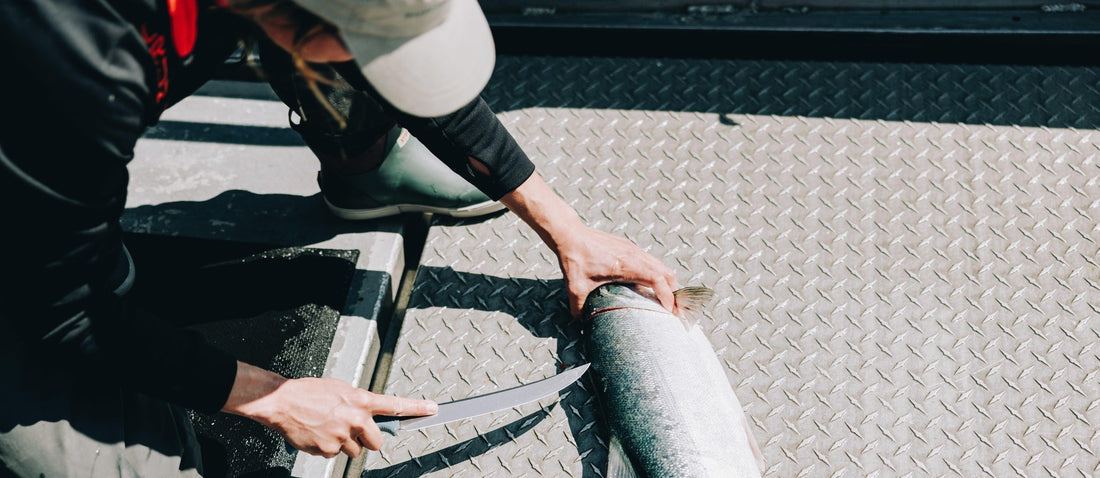A quality fillet knife is more than just a cutting tool; it’s the key to clean, efficient fish prep. Whether you’re filleting a fresh-caught trout or breaking down a large saltwater catch, precision and flexibility are critical for both safety and results. The right knife not only helps you work faster but also ensures minimal waste and cleaner cuts.
Benchmade’s Water Collection of knives is built for anglers who demand performance on the water. In this guide, we’ll cover what makes a great fillet knife, break down the Benchmade options, and share tips to help you choose and care for your ideal blade.
What Makes a Great Fish Fillet Knife
A high-performing fillet knife combines material quality, thoughtful design, and functional features. Here’s what to consider:
Blade Material & Corrosion Resistance
Saltwater and moisture exposure demand a corrosion-resistant blade. Stainless steels with protective coatings, or marine-ready steel compositions, are ideal for long-term performance.
Flexibility & Blade Length
Flexible blades help you glide along bones and skin at an optimal angle that prevents tearing and improves precision. Shorter blades (5–7") are ideal for small to medium fish, while longer blades (9"+) make larger sport fish easier to manage.
Handle Design & Grip
Filleting is often wet work. A slip-resistant grip, such as Santoprene® or textured polymers, ensures safety and control, even when hands are cold or wet. Ergonomic design provides a comfortable and secure grip, preventing the knife from rolling or slipping in your hand.
Sheath or Storage for Safety
Look for knives that include a molded or secure-fitting sheath for safe carry and storage, especially if you're traveling or storing gear in a tight kit. Sheaths should have drainage features to prevent corrosion.
Benchmade’s Best Fillet Knives for Fish
When it comes to preparing your catch with precision and ease, Benchmade offers purpose-built fillet knives designed to meet the needs of serious anglers. Below are the top picks, each crafted for specific fishing styles and species.
18010 Fishcrafter® 7" Fillet Knife

Designed for precise and effortless filleting, the 7-inch Fishcrafter® features a trailing-point blade made from CPM MagnaCut stainless steel. This high-performance alloy offers top-tier corrosion resistance, excellent edge retention, and the toughness required for a durable and flexible blade. In short, you’ll be able to fillet far more fish with a MagnaCut blade than any of the other saltwater steel in the fillet knife category.
The Santoprene® handle provides a secure, slip-resistant grip, even in wet environments, while the included molded sheath ensures safety and portability whether you’re on a boat, pier, or riverbank. The knife’s flexible blade and thin profile, coupled with our proprietary SelectEdge® sharpening technology, make it ideal for powerful push-cutting, deboning, and effortlessly smooth filleting.
Best for: Processing small to medium fish like rockfish, trout, and walleye
18020 Fishcrafter® 9" Fillet Knife

The 9-inch Fishcrafter® delivers extended reach and control for larger species. Like its 7-inch counterpart, it’s made with MagnaCut stainless steel, offering premium corrosion resistance and reliable edge performance in saltwater or high-volume use cases.
The longer and broader blade glides easily along the spine and ribcage of bigger fish, while the durable Santoprene® handle enhances grip security thanks to a finger guard with jimping to prevent slipping during push-cuts. It also comes with a molded sheath for safe storage and quick deployment when needed. This knife is designed for precision push-cutting and flawlessly smooth filleting, engineered to handle demanding environments through superior corrosion-resistant construction.
Best for: Processing medium to large fish, such as tuna, salmon, and sturgeon.
A Perfect Companion for the Water: 18060 Adira™

The 18060 Adira™ is a dependable, all-purpose fishing knife designed for the demands of life on the water. It’s Benchmade’s first premium folding water knife, built with MagnaCut stainless steel, a high-performance alloy with excellent corrosion resistance, toughness, edge retention, and sharpenability.
Its drop-point blade and compact folding design make it ideal for tasks like scaling, gutting, prepping bait, and general utility. The textured Grivory® handle provides a sure grip in wet conditions, and the lightweight build makes it a natural fit for tackle boxes or pockets.
Pair the Adira™ with your Fishcrafter® fillet knife for a complete on-the-water setup, ready from the first cast to the last.
Best for: anglers looking for a versatile companion knife to handle utility and prep tasks on freshwater or saltwater fishing trips.
How to Choose the Right Fillet Knife for Your Needs
What blade size do I need?
Match the blade length to the fish species you typically handle. A 7" knife is versatile for most freshwater fish, while a 9" blade is ideal for larger species.
Where are you fishing?
Saltwater demands corrosion-resistant materials, while freshwater allows for more flexibility. Select a knife tailored to your typical environment to maximize the effectiveness of your gear.
One knife or more?
If you regularly catch a range of fish sizes, it’s worth having two fillet knives; one compact and one with a longer blade, so you're always prepared.
Need a compact companion for your kit?
While not a fillet knife, the Adira™ is a compact, corrosion-resistant folding knife ideal for everyday tasks anglers often encounter on the water—cutting line, prepping bait, or handling small utility jobs. It's a smart addition alongside your fillet knife, especially when packing light.
Not sure what’s best for your fishing style? Try the Benchmade Knife Finder Tool to get a personalized recommendation.
Maintenance Tips to Keep Your Fillet Knife Performing
Even top-tier fillet knives need occasional care to stay in peak condition:
-
Rinse thoroughly after every use, especially after exposure to saltwater.
-
Dry thoroughly before storing to prevent corrosion.
-
Store in a sheath to avoid damage or dulling during transport.
-
Avoid dishwashers; hand washing preserves the blade and handle.
Use Benchmade's LifeSharp® Service if your knife starts to feel dull or isn’t slicing as smoothly. It's a free way to restore your blade to a factory-sharp edge as often as needed.
Why Choose a Benchmade Fishing Knife
With a legacy of excellence dating back to 1987, Benchmade has been crafting premium knives from its headquarters in Oregon, USA. Built for reliability and precision, each Benchmade fishing knife is designed to perform in challenging environments, from the salt spray of open water to the grit of rocky riverbanks. The brand’s commitment to quality is reflected in every detail, from corrosion-resistant blades to ergonomically designed handles that ensure a confident grip, even in wet conditions.
What sets Benchmade apart is not just performance, but peace of mind. Every knife is backed by a lifetime warranty and our complimentary LifeSharp® Service, which offers free sharpening to keep your blade river-ready. Whether you're a weekend angler or a seasoned pro, Benchmade delivers the durability, innovation, and expertise you need to fish with confidence.

Frequently Asked Questions
What’s the difference between a fillet knife and a boning knife?
Fillet knives are thin and flexible, built for the delicate work of removing skin and gliding over bones when separating meat. Boning knives are stiffer, designed to cut around bones and separate the dense meat of larger animals or tougher cuts.
Can you fillet a fish without a fillet knife?
Yes, but it can lead to more waste, uneven fillets, and a slower, less efficient process. Fillet knives are designed for precision and flexibility, enabling you to make clean, controlled cuts and extract the most meat, especially when working around delicate bones.
Can you use a fillet knife for meat?
While designed for fish, fillet knives can be used for boneless meats like chicken or pork. However, their flexible blades are best suited for delicate, precise cuts. For denser, bony meat, a stiffer blade is prefferable.
How often should I sharpen my fillet knife?
Sharpen your fillet knife when you notice it dragging or tearing the meat. For regular anglers, light honing after every few uses and professional sharpening as needed keeps the edge razor-sharp and ready for use.
Are fillet knives dishwasher safe?
No, dishwashers can dull the edge and damage the handle over time. To extend the life of your knife, always wash it by hand, dry it thoroughly, and store it safely in a sheath or knife block.


